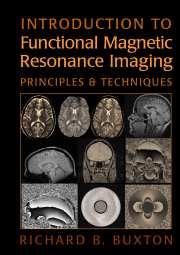9 - Diffusion and the MR Signal
from IIA - The Nature of the Magnetic Resonance Signal
Published online by Cambridge University Press: 05 September 2013
Summary
INTRODUCTION
Water molecules in the body are in constant motion. In Chapter 8, we considered how these thermal motions lead to random rotations of the water molecule, producing fluctuations of the local magnetic field felt by the hydrogen nucleus. These fluctuating fields lead to relaxation; in particular, the low-frequency fields reduce T without affecting T. But in addition to random rotations of the molecule, thermal motions also produce random displacements, the process of diffusion. In a nonuniform magnetic field, as a spin moves randomly to another position, there are corresponding random changes in its precession rate, and thus an additional dephasing of the spins and greater signal loss. This additional signal decay due to diffusion through inhomogeneous fields is exploited in three ways in magnetic resonance imaging (MRI). First, by applying a strong linear field gradient and measuring the additional signal attenuation, the local diffusion coefficient D can be measured. This is the basis of diffusion imaging, and one of the primary applications of diffusion imaging is in early assessment of injury due to stroke (Baird and Warach, 1998). Conventional MRI does not reveal the affected area in stroke until several hours after the event, when T changes become apparent. But the apparent diffusion coefficient is reduced very early in the development of a stroke, and maps of altered D in the acute phase correlate well with the T maps of the affected area made several hours later.
Second, the ability to measure the local diffusion coefficient provides a potentially powerful tool for mapping the connections between brain regions (Conturo et al., 1999).
Information
- Type
- Chapter
- Information
- Introduction to Functional Magnetic Resonance ImagingPrinciples and Techniques, pp. 185 - 216Publisher: Cambridge University PressPrint publication year: 2002
Accessibility standard: Unknown
Why this information is here
This section outlines the accessibility features of this content - including support for screen readers, full keyboard navigation and high-contrast display options. This may not be relevant for you.Accessibility Information
- 3
- Cited by
